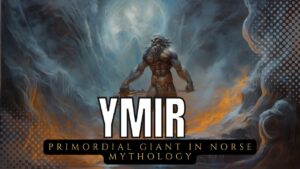In Ymir Norse mythology is a primordial giant who plays a significant role in the story of how the universe came to be. A creature born from the explosive collision of ice and fire, he ate cosmic bovine poop and became the material for the cosmos. He can procreate independently, and one of his progeny is the woman who gave birth to Odin. However, Odin and his brothers would murder him and use his corpse as raw material to fashion the universe. The sky would be made up of disorganized thoughts, and his eyebrows would mark off the boundaries of the continents and oceans.
The Icelandic scholar and law speaker Snorri Sturluson, who attempted to retell these stories in a text called Gylfaginning, part of a more extensive book called the Prose Edda, provides a detailed account of the Norse creation myth in the 13th century CE. The Elder or Poetic Edda, a collection of poems compiled in the same century but thought to be much older because of its language and substance, inspired him. Snorri’s writings should be interpreted cautiously because it is unclear how much of the older Norse tale he created. The Swedish folktale Gylfaginning recounts the story of the legendary king Gylfi, who travels to the home of the gods, Asgard, to inquire whether the gods employ magic to carry out their will. Even though Gylfi is tricked into thinking he is communicating with the gods and that the palace he arrives at is genuine, he eventually discovers solutions to his burning cosmological questions.
Snorri starts by paraphrasing the first text in the Poetic Edda, a Völuspá, which states that there was just a vast nothingness replete with magical potential before anything else. The world we now name home was once called Niflheim, and it was a cold, foggy place with a well from which eleven rivers gushed. Muspell, the opposite polar planet, was blazingly hot and abrasive. The subsequent events are murky, possibly because different mythological accounts were combined to form a single story. It appears that the central concept is that rime met heatwaves from Muspell and caused the waterways of Niflheim to freeze, causing ice to pile up in the void. The melting caused the droplets to coalesce into a being, either Ymir or Augelmir, the progenitor of the giants. Whether true or not, this is a vivid tale: Ymir’s perspiration conceived a male and female child, and his legs produced a child.
When the ice of Niflheim melted, it created more than just Ymir. Similarly, Ymir’s cow, Audhumla, whose rime assumed the form of a cow, helped sustain him. The cow’s nutrition consisted almost entirely of licking rime blocks coated in salt. She used the time to make a man named Bri, who had a boy named Borr. The gods Odin, Vili, and Vé descended from Borr and his gigantic wife, Bestla. The latter two are shrouded in mystery, but the former attained the pinnacle of the divine hierarchy. All worshipped it for having leadership, wisdom, deceit, magic, pragmatism, and grit, among other qualities.
In the end, the divine triumvirate perpetrated the murder, forming the foundation of all around us. After killing Ymir, the giant spilt so much of his blood and streamed that all but one family of giants perished. At last, the three gods had the resources they needed to construct Earth. To no one’s surprise, his blood turned into the sea that, in Ymir Norse mythology legend, encircled the world and made passage impossible. Austri Vestri, Nordri, and Sudri became the four points, or more correctly dwarves, that held his skull together, representing the sky.
The gods then plucked sparkles from the air emanating from Muspell at random and hurled them into the heavens to form the stars and bring light to the world. Even so, they readjusted their trajectories. At this point, Gylfi, the king asking many questions regarding the gods, the cosmos, and everything else, introduces himself as Gangleri and expresses his awe and desire for more knowledge. The races of giants, he is informed, reside on the shores of the circular Earth, which is surrounded by a sea. The gods used another part of Ymir, his eyelashes, to construct a fortification on the interior side of the earth, shielding the worlds from the aggressive giants.
Some Iranian as well as Indian myths feature characters who are like Ymir—hermaphrodites who can play both parental roles. Zorvanism’s god Zorvan, for instance, is credited with giving rise to the gods of light and darkness, Ahura Mazda and Angra Mainyu. The sacred book of ancient India, the Rigveda, tells the tale of Purusha, a primal being who was sacrificed and divided up to give birth to the caste system, the solar system, the celestial bodies, and the gods Indra and Agni. The Indo-Iranian word for “twin,” Yama, may have a counterpart in the name Ymir.







